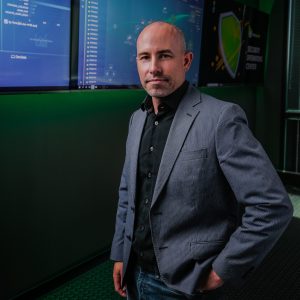In 2023, Blackpoint Cyber secured one of the largest deals in the cybersecurity world—a $190 million investment from Bain and Accel.
As a former NSA computer operations expert Blackpoint Founder and CEO Jon Murchison brings a unique perspective to developing and assessing cyber defense software.
Here, he shares what time in tech so far has taught him.

What first made you think of a career in cybersecurity?
It all started with networking. Early in my career building networks fascinated me and sparked my curiosity. I was intrigued by the idea of either joining the military after college or entering the intelligence community. Ultimately, I joined the National Security Agency and this experience steered me towards the path of cybersecurity.
What is your favorite challenge of growing a company?
The challenge I like the most in growing a company is the art and science of building a robust go-to-market strategy for rapid growth. We already have an exceptional cybersecurity product that integrates with all Endpoint Detection and Response tools, making it highly effective. However, the real test lies in managing fast growth without compromising the high standards we’ve set for ourselves.
The actual task of catching hackers isn’t the toughest part; it’s building a world-class organization. I’ve learned that hiring is one of the most crucial tasks I can undertake, particularly when assembling an elite executive leadership team. Even a mediocre strategy can be successful if the right players are on the field. Our strategy is strong and success hinges on execution.
In 2023, we secured one of the largest deals in the cybersecurity world—a $190 million investment from Bain and Accel. This was a significant vote of confidence in us – but it also underscored the importance of maintaining solid business fundamentals even amidst rapid growth.
What is the biggest cybersecurity challenge your customers need to keep their eye on, in the next few years?
Undoubtedly cloud security. The COVID-19 pandemic led to a mass migration towards a cloud-first strategy, leading to a significant increase in authentication authorizations and platforms such as Microsoft 365, Google Workspace and Azure. As more core IT assets are placed behind single sign-on systems in the cloud, they become prime targets for hackers.
We were the first company globally to implement active detection and response on Microsoft 365 and Azure single sign-on. We’ve noticed that the volume of attacks on these platforms is five times higher than on-premises attacks, leading to ransomware incidents. Ransomware isn’t going away anytime soon.
Therefore, securing cloud workflows and single sign-on services should be a top priority.
Blackpoint Cyber is focused on MSPs – what is your strategy to help them succeed?
First and foremost, we acknowledge the challenges MSPs face – retaining quality IT talent, acquiring new customers, retaining existing ones and navigating the complex cybersecurity landscape. We aim to take the heavy lifting of security work off the MSPs’ shoulders, allowing them to focus on their core competencies.
We’ve adopted what I call the Green Beret Go-to-Market Model. It’s about upskilling the business side of MSPs. They’re already great at IT, so we focus on enhancing the business model. Our product roadmap, pricing, packaging and the extensive educational resources we offer through Blackpoint University are all designed to help upskill these companies.
What do you currently identify as the major areas of investment in your cybersecurity industry?
Security Information and Event Management (SIEM) is a failed technology for catching hackers. Yes, you heard that right. Every major company uses a SIEM, yet they continue to fall prey to cyberattacks. SIEMs are excellent for checking compliance boxes, but their efficacy in thwarting hackers leaves much to be desired.
There’s a sea change coming and we’re going to see industry investment challenge the status quo and fill the strategic gaps currently existing in the cybersecurity landscape.
What are the region-specific challenges when implementing new technologies in North America?
Instead of regional challenges, we see vertical-specific hurdles. Certain industries, like education, often struggle with budget constraints and end up investing in tools that may not provide the most effective solutions. When they assemble a traditional stack with SIEMs and other similar tools, they often exhaust their resources without investing in the solutions that truly work.
Compliance-heavy verticals, such as healthcare and federal sectors, face their own unique challenges.
While they have stringent cybersecurity requirements, the prescribed methods often emphasize compliance over effectiveness.
The challenges in implementing new technologies are not so much geographical, as they are industry specific.
The key is to strike a balance between meeting compliance requirements and investing in effective security measures.
How do you deal with stress and unwind outside the office?
I’m an avid race car driver, so hitting the track and feeling the adrenaline rush helps me destress. That along with music, skiing and snowmobiling are hobbies that help me deal with stress and keep a healthy work-life balance.
What advice would you offer somebody aspiring to obtain a senior management position in your industry?
If you aspire to reach a senior management role in this industry, focus on becoming an active practitioner, gaining hands-on experience and building a strong foundational knowledge of IT.


